The Vestal Virgins played a vital role in safeguarding the flame that represented the hearth of Rome. They were entrusted with this responsibility in service of the goddess Vesta, carrying out her demands with meticulous care and devotion. Of course, the flame had a profound meaning. Roman leaders and citizens believed that as long as the flame burned, Rome would remain protected and successful.
Who exactly were the group of virgins, and how were they elected? And were they successful in keeping the fire burning?
Table of Contents
Who Were Vestal Virgins?
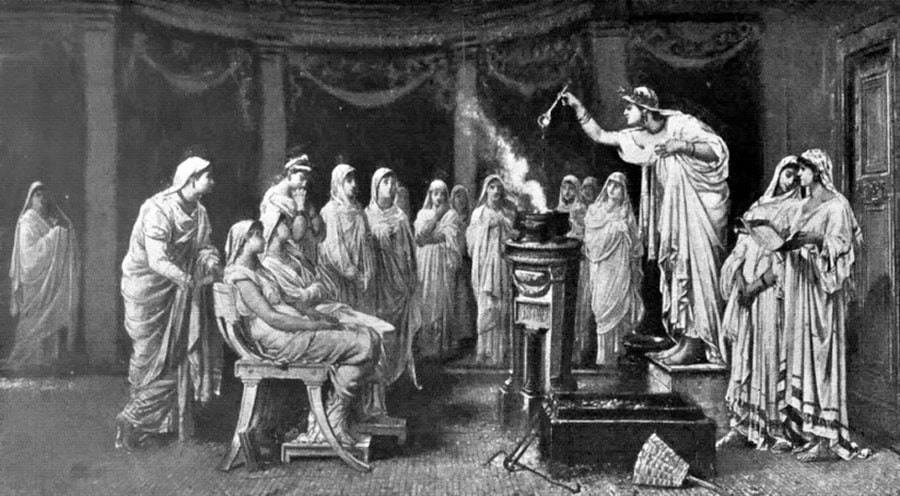
The Vestal Virgins were priestesses of ancient Rome who served the Roman goddess Vesta; the virgin goddess of the hearth, home, and family. A Vestal Virgin was chosen from a noble family and their primary responsibility was to maintain the sacred fire in the Temple of Vesta. The fire represented the continuity of Rome, so the virgins played a significant role in Roman religious and civic life.
The place of residence for the Vestal Virgins was called the Atrium Vestae (House of the Vestals), a place far away from the other Roman women and men. While living there, they had to abide by strict chastity vows for at least 30 years. The women led extraordinary lives, which also made them some of the most influential women of ancient Rome.
Selection Process and Tasks of the Vestal Virgins
Their unique position was due to a couple of factors. For starters, the virgins were only a select group of women chosen by the pontifex maximus – the high priest of Rome. Usually, Roman women were only young girls between six and ten years of age at the time of election by the high priest.
Once selected, they would begin their training as Vestals and be required to have an enormous commitment to their role for about thirty years. Many of their work revolved around the Roman Forum, the place where the flame was located.
Other than maintaining the magical fire, these priestesses brought many religious ceremonies to the Roman population. One of the most important annual events involving the Vestals was the Vestalia – a festival dedicated to the goddess Vesta – during which the temple was opened to the public.
During Vestalia the Roman goddess Vesta was praised and honored for her caretaking over the Roman Empire. Ample sacred relics and rites were performed, all for the sake of protecting the goddess and the Empire as a whole.

Keeper of the Flame
As mentioned earlier, the Vestal Virgins had the crucial task of ensuring the flame in the Roman Forum was never extinguished. The sacred fire was literally one of the most important things in Roman religion and Roman history.
According to the Romans, its extinguishment would bring about disastrous consequences for Rome, so keeping it burning was of utmost importance. On the other hand, the continuous burning signified the ongoing protection, prosperity, and stability of the city and its inhabitants.
To add, as the heart of the Roman state, the flame represented the divine presence within Rome and served as a link between the mortal world and the realm of the gods.
The Vestal Virgins maintained the sacred flame using specific rituals and protocols. They would regularly replenish the fire with wood, herbs, and other materials, carefully following the prescribed procedures to ensure its longevity. The fire was usually kept in a circular hearth or altar within the temple, visible to the public through small openings.
If Vesta’s flame were to burn out, the Vestals could face serious punishment. The worst one would probably be sentencing by the Pontifical College to be buried alive within the city walls. Live burials seem to be a recurring theme as a form of punishment in the ancient tradition of Rome.
The Meaning of the Flame
The flame itself had several different meanings, which were central to the revered position of the group of virgins. The magical fire also played a role in all the ceremonies and festivals relating to the cult of Vesta.
During the annual festival dedicated to the Roman goddess of Hearth, the temple would be opened to the public whilst displaying the sacred relics. This event provided an opportunity for Romans to pay their respects to Vesta, look at her flame, and seek her blessings for their homes and families.
Still, the significance of the fire does not just relate to the state religion. It also held political implications, as the preservation of the flame was closely tied to the well-being and prosperity of Rome. Roman leaders and citizens believed that as long as the flame burned, Rome would remain protected and successful on the battlefield.
Consequently, the Vestal Virgins and their flame had a position of great respect and praise within Roman society. The eternal nature of the flame reflected the timeless nature of Rome itself. It symbolized the endurance of the city, conveying the idea that Rome would thrive and endure as long as the flame continued to burn brightly.
In times of crisis or impending danger, the sacred flame held particular significance. It was believed that the intensity and behavior of the flame could provide insights into the state of the nation.
If the flame burned strongly and steadily, it was interpreted as a positive thing, indicating divine favor and the security of Rome. However, any disruptions or abnormalities in the flame were seen as signs of impending doom or divine displeasure.

Chief Vestal Virgin
Within the community of the virgins, one woman enjoyed a higher position than the other women. In a sense, her position resembles the position of the Pope. Still, the religion of the Roman Empire and the eventual Vatican varied significantly, so a one-on-one comparison doesn’t do justice to the vast differences between the two. Still, as a point of reference, it suffices.
The chief virgin was known as Virgo Vestalis Maxima, which translates to the ‘Supreme Vestal Virgin’ or the ‘High Priestess of Vesta’. This chief priest was elected from the group of Vestal women that were already in service and was seen as the senior and most prominent member of the group.
She was responsible for overseeing the activities of the other Roman Vestal Virgins, ensuring the proper maintenance of the sacred fire. Also, she was the main woman in charge of the performance of religious rituals associated with the goddess Vesta.
The Virgo Vestalis Maxima eventually also played a central role in various state ceremonies. Her presence and participation in public events added to the importance of the ceremonies, bringing a divine presence.
The chief priest enjoyed certain privileges and distinctions because of her position. She wore distinctive attire, including a special white robe and a unique headdress called the ‘infula’. Her appearance distinguished her from the other Vestal Virgins and emphasized her elevated status.
The position of Virgo Vestalis Maxima was typically held for life, and upon the death or retirement of the incumbent, a new Virgo Vestalis Maxima would be selected.
The selection process often involved consultation with Roman authorities and religious officials to ensure the appointment of a suitable candidate.
A Life of Restriction
The Vestal Virgins enjoyed certain privileges and honors within Roman society. They were granted prominent seating at public events, had the authority to free condemned prisoners, and were exempt from certain obligations, such as attending funerals.
They were held in high regard by the Roman population, and it was believed that the presence of a Vestal Virgin brought good fortune and divine protection to any public gathering.
However, the role of the Vestal woman was not without its challenges. The women who undertook this sacred duty had to make significant sacrifices.
They were cut off from their families, unable to marry, and had to forgo the opportunity to have children and heirs as long as they were part of the community. Their lives were dedicated entirely to the service of Vesta and the welfare of Rome.
The inability of Rome’s Vestal Virgins to marry and have children was a result of the prolonged chastity that they had to abide by. They took a vow of celibacy for the duration of their service (thirty years), which was seen as a way to preserve their purity and maintain their spiritual connection with Vesta.
If they broke the vow it was considered a grave offense, as it was believed to bring about the wrath of the gods and could potentially endanger the entire Roman state.
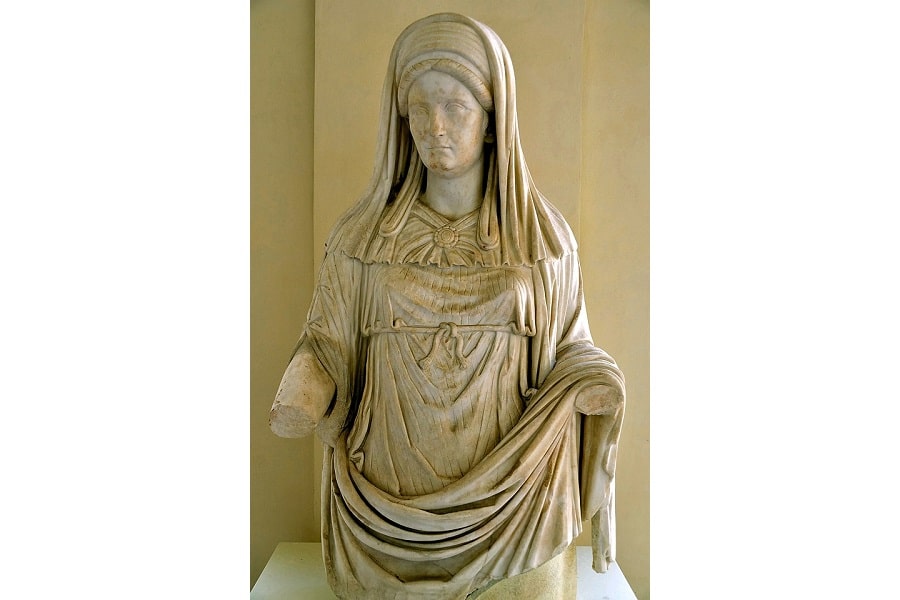
Did Any Vestal Virgin Have Children?
The primary responsibility of Vestal Virgins was to uphold their chastity and devote themselves entirely to the worship of Vesta. This way, they remained completely pure beings. Instances of childbirth were therefore extremely rare, if not unheard of, and were considered scandalous. Such cases were met with severe consequences.
How Many Vestal Virgins Were Killed?
According to historical accounts, if a Vestal Virgin was found to have broken her vow and became pregnant, she would face harsh punishment. This included being buried alive as a form of ritual execution. Still, the precise number of Vestal Virgins who faced capital punishment in such a manner is uncertain, and the available historical records may not provide a comprehensive account of every individual case.
While the penalty for extramarital sex for other women was quite minor, the virgins evidently had a different destiny. The penalty was specifically designed to both punish the individual and serve as a deterrent to others, who might’ve been considering violating their own vows.
One of the most well-known cases of a Vestal Virgin buried alive due to the violation of her vow of chastity was that of Vestal Virgin Cornelia. However, she was a fictional character created by the Roman historian Tacitus. Tacitus used Cornelia as a literary device to depict the consequences faced by Vestal Virgins who broke their vows.
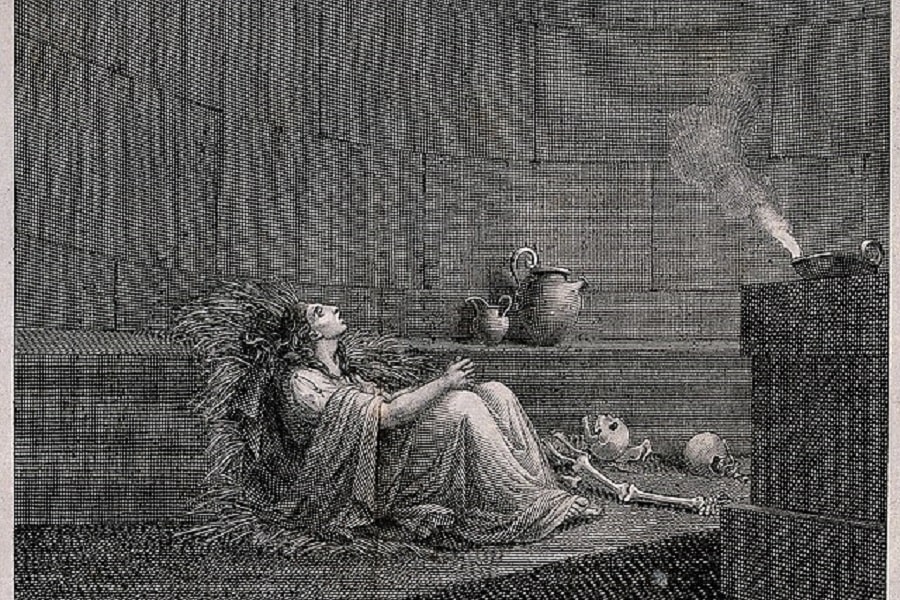
Three Periods over Thirty Years
The residence, the pleasant villa called the House of Vestals, provided the women with a secluded environment, shielding them from outside influences that might compromise their chastity. They lived in a communal setting and followed a strict set of rules and regulations.
They held their positions until the age of 40 when they were released from their vows and allowed to leave the priesthood. At this point, the virgins were free to marry and live a more conventional life. Those who completed their service with honor were granted a pension and could enjoy a certain degree of social status in their post-Vestal life.
The life of the Roman women when taking the position of a Vestal Virgin was divided into three stages.
Novice Period
The first period was called the novice period, which typically lasted around ten years. This period involved extensive education and training, with the help of guidance from the older virgins. Learning about religious rituals, history, traditions, and responsibilities was the main focus during this period.
It was not just theoretical training, of course. Novices would also begin to participate in religious ceremonies and rituals, assisting the more experienced Vestal Virgins. They would observe and learn the rituals, gradually becoming familiar with the practices and protocols associated with the worship of Vesta.
Lastly, this period also served as a crucial phase for the novices to internalize and strengthen their commitment to celibacy.
Service Period
The second period was equally long in length. This stage marked their full induction into the Vestal Virgin institution. From now on, they would actively fulfill their religious and custodial duties.
Their main duty was now to maintain the fire. Their supportive roles in ceremonies and rituals converted to active participation and organization of various religious rituals and ceremonies. They would perform rites dedicated to Vesta, making offerings and prayers on behalf of Rome and its citizens.
Over time, the political role of the community also increased significantly. Because of this, they were entrusted with the safekeeping of important state documents and treasures. Guarding and organizing records became part of their everyday lives.
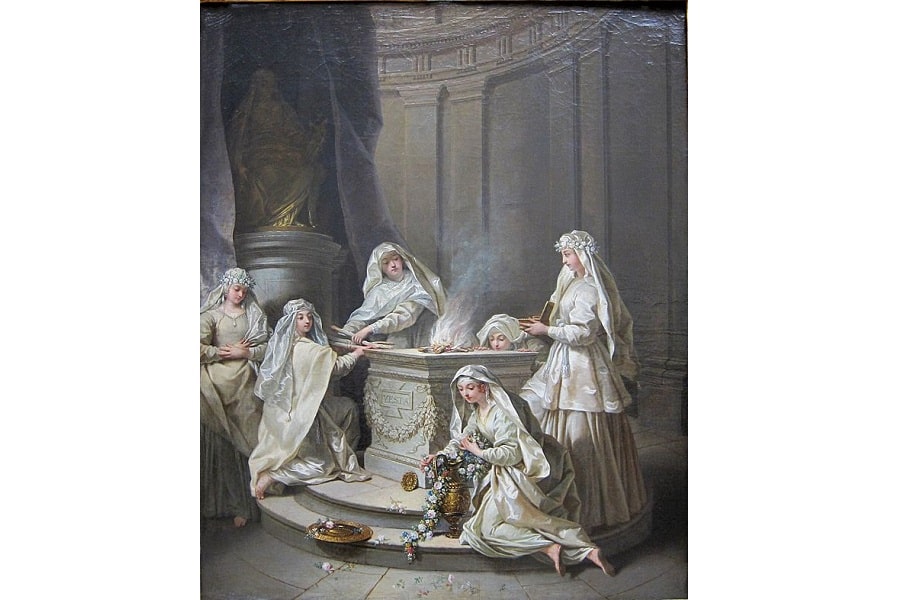
Period of Seniority
In the final stage of their thirty-year commitment, Vestal Virgins would reach the period of seniority. This stage acknowledged their experience and senior status within the Vestal Virgin community.
Their main role was now to provide leadership and mentorship to the influx of other women. They would guide and train them, passing down their knowledge, wisdom, and the sacred traditions of the Vestal Virgin institution.
Since the senior Vestal women were most acquainted with the work of the group, they represented the Vestal Virgin community in public functions and ceremonies. They would take part in important state events, adding significance and religious authority to the proceedings.
At the completion of their thirty-year commitment, the senior Vestal Virgins would retire from their duties as active members of the Vestal Virgin institution.
What Happened to the Vestal Virgins?
Over the centuries, the role and fate of the Vestal Virgins underwent significant changes, reflecting the evolving religious, social, and political landscape of ancient Rome. While their tasks were originally limited to the religious realm, eventually they had an important political presence. An eventual shift in moral values led to their unexpected fast demise, to the point that the institution was abolished altogether.
In the early years of Rome, the Vestal Virgins played a pivotal role in the religious rituals and ceremonies of the city. As discussed, they were believed to have the power to bring good fortune, prosperity, and divine protection to Rome. Their presence at public events was considered auspicious, and they enjoyed privileges and honors within society.
As Rome grew and transformed politically and culturally, so did the role of the Vestal women. In addition to their religious duties, they took on responsibilities related to the preservation of important documents and state treasures.
The group was entrusted with safeguarding wills, treaties, and other valuable records related to Roman law in the official archive of their institution.
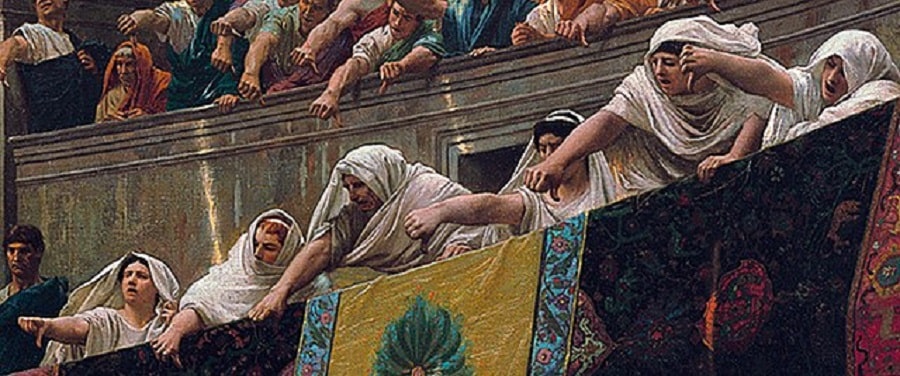
READ MORE: The Complete Roman Empire Timeline: Dates of Battles, Emperors, and Events
The Decline of the Vestal Women
Over time, the influence and prestige of the Vestal Virgins declined. The rise of Christianity in the later years of the Roman Empire, with its different religious beliefs and practices, brought about significant changes in ancient Rome.
Traditionally, the Roman Empire followed a polytheistic religion, meaning they worshiped many different gods. Vesta was one of these gods and, obviously, the whole role of the Vestal women depended on the importance of Vesta.
However, because of Christianity, Vesta and many other Roman gods lost their prominence. Because of it, the role of the Vestal Virgins became less relevant in the new religious landscape.
READ MORE: How Did Christianity Spread: Origins, Expansion, and Impact
Social and Cultural Changes Leading to Decline
The decline of the Vestal Virgin institution was also influenced by social and cultural changes within Roman society. The shift in moral attitudes, the erosion of traditional values, and the declining emphasis on chastity and purity diminished the significance of the Vestal Virgins’ vow of celibacy.
While their political importance was peaking in the years before, the increasing power and influence of Roman emperors and the imperial court eventually overshadowed the role of the virgins in public life.
In 394 CE, the Christian Emperor Theodosius I officially abolished their institution, marking the end of an era. The Temple of Vesta was closed, and the sacred fire that had burned for centuries was extinguished.
Following the dissolution of the institution, the fate of the remaining Vestal women varied. Some retired with pensions and lived out their lives in relative comfort, while others were assimilated into different roles within Roman society.
The Atrium Vestae, which housed the community, was repurposed, and the physical remnants of their presence gradually faded away. Still, the legacy of the extraordinary women is ongoing. Their image persisted in art, literature, and folklore, symbolizing the virtues of chastity, purity, and devotion.
The stories and legends surrounding the Vestal Virgins served as moral lessons and cautionary tales.